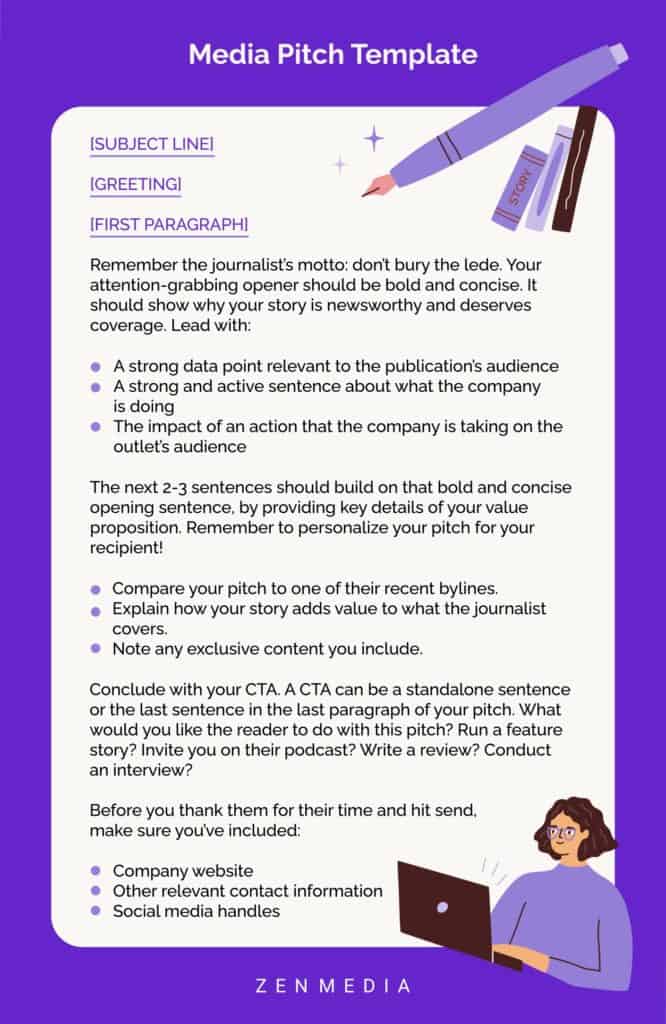Getting (and holding) the attention of content creators—especially high-caliber ones—is a feat. And that feat must be accomplished for successful PR outreach. A study by Muck Rack found that 34% of PR professionals say finding and interacting with journalists is one of their biggest challenges. While challenging, it certainly isn’t impossible.
But to write successful media pitches—ones that get your brand featured in top-tier publications and shows—you need to understand what is newsworthy, how to identify the best angle to your topic, and become familiar with the things journalists, editors, and podcasts look for most in a pitch.
What is PR outreach?
PR outreach is a form of marketing that helps you get your brand in front of the right people. It involves promoting (pitching) information about your products and services to journalists, bloggers, and people with influence in your industry, aiming to get press coverage and brand mentions.
How to Write a Killer Media Pitch
The first thing you have to do is tell the reporter what’s so newsworthy about your topic. You may have a great story, but if it’s not something that will be of interest to their publication or podcast, it won’t make much difference. Explain why writing about your company would be mutually beneficial for both parties involved. Imagine every pitch recipient will ask, “Why should I care about what you’re doing? How will my readers benefit from reading about it?”
You need a clear, compelling answer.
Related reading: 6 Common Mistakes B2B Brands Make When Pitching Media

What do journalists, editors, and podcasters want in a media pitch?
Keep it short.
The key to a good media pitch is brevity, so make sure you get to the point quickly and clearly. Online journalists are often bombarded with pitches from PR professionals and influencers, so they need to be able to read through yours and understand the key points quickly—if you send a wall of text, expect your pitch to get pitched—into the trash, that is.
This is one of the most common mistakes people make when writing their first pitch. They assume that because they’re excited about a story, everyone else will be as well. They also think that if they share every last detail about their product or service in the first paragraph, it won’t come off as salesy or self-promotional (it does). This can lead them to include all sorts of superfluous details about their company’s history and background—which gets off track and bores your reader.
Related reading: How To Make Boring Company News Into a Press-Worthy Story
Personalize your pitch.
People want to connect with people. If you send the same email pitch to every reporter, a robot might as well have done it. Show your pitch recipients that you’ve done your research on them by pitching topics they regularly cover but with a new angle or development. Now, don’t cyberstalk anyone and mention, “Say hello to Jerry, your pit-bull-terrier mix for me!” in your first email. That’s—just creepy. But you can reference articles, episodes, or content they’ve created that shows they are a good fit for your pitch.
The key is to show them that you’ve paid attention to their interests and invested time in reading their previous work. In a pile of press releases, personalization stands out.
Related reading: How to Get Your B2B Tech Brand Tier 1 Press
Add visuals.
Data shows that journalists want infographics and data visualizations, and don’t forget the rise in video popularity. Journalists aren’t immune to trends, and it is likely that a unique video pitch will get noticed. However, if there are strict rules for pitch submissions, be sure to follow those before going overboard on design elements. Seriously, sometimes a simple infographic with valuable data is more than enough.
Don’t oversell.
It’s easy to get caught up in the excitement of your company’s news and let your enthusiasm overflow, but journalists don’t want a sales pitch. Instead, their goal is to find a story that will interest their readers, so they need information without being bombarded by marketing speak.
Instead of relying on your sales language, find strong support for your messaging in compelling stories and intriguing statistics. How does the research you’ve done impact the publication’s audience? What about your new collaboration or groundbreaking innovation—is it meaningful to the listeners, readers, watchers, etc.?
Tell a story that catches their interest. Grab their attention with an eyebrow-raising stat. But be genuine about it, not salesy and promotional.
Related reading: PR Checklist Proven to Maximize Results
Send exclusive content.
Content creators of all kinds love exclusive content. It draws an audience in before any other publication gets a chance. It’s a big deal to break news when the news is interesting to their audience. While this is a great PR strategy when you want to swing big with a really influential pitch, don’t offer exclusive content constantly, or you’ll be like the boy who cried wolf.
As with any other kind of PR, some companies will offer exclusivity in exchange for coverage—but again, this should be part of an overall PR campaign rather than something you just start doing randomly because you feel like it might help out at some point down the road.
Build rapport (before pitching).
Building rapport with the person you are pitching is key to getting their attention and having them write about you. This can be as simple as retweeting their stories every so often, commenting on new posts, and engaging with them on social media. Of course, it is beneficial if you’ve actually met the person you’re pitching to, but in our ever-evolving digital world, that’s not always possible. Connections can be transcontinental.
Again: Don’t be a creeper and badger them about Jerry, their pitbull-terrier mix. Your rapport should be tied to the business relationship you wish to develop.
Be friendly but professional.
This is especially important when reaching out to journalists and reporters because they can receive upwards of 30 pitches a day, so they need you to be concise and clear in your message. The last thing they want is someone who is rambling on about their product or service for several paragraphs before even mentioning what it does (or why it matters). So yes, be kind. Be personal, but keep it all professional. (Remember, leave Jerry out of this!)
Related reading: Is Your PR Agency Getting You Enough Coverage?
Be patient and persistent (but not annoying).
You may only get one shot at reaching out, so make sure that all of the information provided in your pitch is relevant enough for them to consider writing about it—and make sure to adhere to the follow-up instructions (if any were provided).
Many journalists and podcasters are bombarded with pitches, so following up on something they deemed uninteresting will only clutter their inboxes. That said, because of their full inboxes, it’s also possible that a great pitch was buried, and they’d love to be reminded about it. The key here is to respect their preferences. Some journalists ask you to only follow up once, others may indicate a time frame after which you may follow up, i.e. “Please allow a full week to pass before following up.” The information on your target’s preferences is usually available in their bios on social media or whichever platform they use to manage outreach.
PR outreach is a core part of any marketing plan. Between 25 and 40% of website traffic and lead generation come from earned media—and that doesn’t count the leads that will come with social amplification of the press hit. If you’d like to see your brand land media appearances and company mentions, reach out. We’d love to help.





